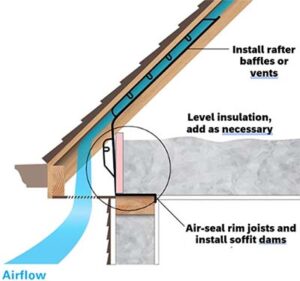Wind washing: It’s not a new, evolutionary way of laundering clothes. It’s not a water-conserving approach to personal hygiene. It’s not even a technique for cleaning dirty windows. Rather, wind washing is the movement of unconditioned air around or through buildings in such a way that diminishes or nullifies the intended thermal performance. More simply put, wind washing may be eroding the benefits of your home’s insulation, especially in the attic.
Therefore, it could be causing your home to use more energy during heating and cooling seasons.
Most often, wind washing is caused by airflow coming through the soffits or roof vents into unconditioned attic spaces. While air movement is necessary for proper ventilation, it shouldn’t move through insulation. When it does, gusts can push loose-fill insulation out of place, causing bare spots and uneven insulation. Blown-in fiberglass and rockwool insulation are most vulnerable to its effects. Typically, the problem starts in open, vented soffit areas where roof trusses set on the top plate of exterior walls.
The solution is to direct air flow within the attic while eliminating its opportunity to pass through insulation as illustrated in the image.

Source: Over the Top Roofin
Start by raking loose-fill insulation away or pulling blanket insulation back from vented soffit areas. Air seal rim joists and drywall seams with spray foam insulation. Also seal floor cavities below attic knee walls and cantilevered floors, if necessary. Install rafter baffles or vents at each rafter bay to direct air flow above rather than through attic insulation. Cut foam board to snuggly fit between ceiling joists and install them to serve as soffit dams. These should extend four inches above the final level of insulation where possible. Remember, the US Department of Energy recommends insulating attics in Nebraska to an R-value of 49. This will likely require an insulation depth of 16 to 18-inches. Redistribute existing insulation back evenly into affected areas and add new insulation as necessary. If wind washing continues in problem areas, consider installing a roll of batt insulation over the top to confine loose-fill insulation. As part of home maintenance, remember to inspect attic spaces annually for the effects of wind washing and settling insulation.
Your local utility in partner wants to help you gain the most value from the energy required to heat and cool your home. Qualified customers may be eligible for EnergyWiseSM attic insulation incentives to help with improvement costs.
